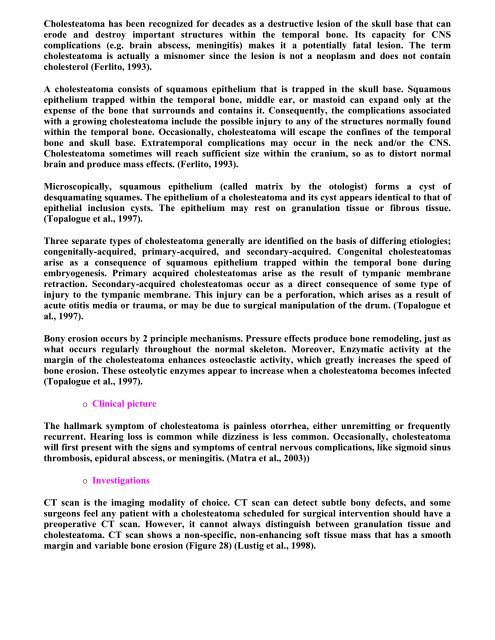INTRODUCTION Granulomatous inflammation is a distinctive ...
INTRODUCTION Granulomatous inflammation is a distinctive ...
INTRODUCTION Granulomatous inflammation is a distinctive ...
Create successful ePaper yourself
Turn your PDF publications into a flip-book with our unique Google optimized e-Paper software.
Cholesteatoma has been recognized for decades as a destructive lesion of the skull base that can<br />
erode and destroy important structures within the temporal bone. Its capacity for CNS<br />
complications (e.g. brain abscess, meningit<strong>is</strong>) makes it a potentially fatal lesion. The term<br />
cholesteatoma <strong>is</strong> actually a m<strong>is</strong>nomer since the lesion <strong>is</strong> not a neoplasm and does not contain<br />
cholesterol (Ferlito, 1993).<br />
A cholesteatoma cons<strong>is</strong>ts of squamous epithelium that <strong>is</strong> trapped in the skull base. Squamous<br />
epithelium trapped within the temporal bone, middle ear, or mastoid can expand only at the<br />
expense of the bone that surrounds and contains it. Consequently, the complications associated<br />
with a growing cholesteatoma include the possible injury to any of the structures normally found<br />
within the temporal bone. Occasionally, cholesteatoma will escape the confines of the temporal<br />
bone and skull base. Extratemporal complications may occur in the neck and/or the CNS.<br />
Cholesteatoma sometimes will reach sufficient size within the cranium, so as to d<strong>is</strong>tort normal<br />
brain and produce mass effects. (Ferlito, 1993).<br />
Microscopically, squamous epithelium (called matrix by the otolog<strong>is</strong>t) forms a cyst of<br />
desquamating squames. The epithelium of a cholesteatoma and its cyst appears identical to that of<br />
epithelial inclusion cysts. The epithelium may rest on granulation t<strong>is</strong>sue or fibrous t<strong>is</strong>sue.<br />
(Topalogue et al., 1997).<br />
Three separate types of cholesteatoma generally are identified on the bas<strong>is</strong> of differing etiologies;<br />
congenitally-acquired, primary-acquired, and secondary-acquired. Congenital cholesteatomas<br />
ar<strong>is</strong>e as a consequence of squamous epithelium trapped within the temporal bone during<br />
embryogenes<strong>is</strong>. Primary acquired cholesteatomas ar<strong>is</strong>e as the result of tympanic membrane<br />
retraction. Secondary-acquired cholesteatomas occur as a direct consequence of some type of<br />
injury to the tympanic membrane. Th<strong>is</strong> injury can be a perforation, which ar<strong>is</strong>es as a result of<br />
acute otit<strong>is</strong> media or trauma, or may be due to surgical manipulation of the drum. (Topalogue et<br />
al., 1997).<br />
Bony erosion occurs by 2 principle mechan<strong>is</strong>ms. Pressure effects produce bone remodeling, just as<br />
what occurs regularly throughout the normal skeleton. Moreover, Enzymatic activity at the<br />
margin of the cholesteatoma enhances osteoclastic activity, which greatly increases the speed of<br />
bone erosion. These osteolytic enzymes appear to increase when a cholesteatoma becomes infected<br />
(Topalogue et al., 1997).<br />
Clinical picture<br />
The hallmark symptom of cholesteatoma <strong>is</strong> painless otorrhea, either unremitting or frequently<br />
recurrent. Hearing loss <strong>is</strong> common while dizziness <strong>is</strong> less common. Occasionally, cholesteatoma<br />
will first present with the signs and symptoms of central nervous complications, like sigmoid sinus<br />
thrombos<strong>is</strong>, epidural abscess, or meningit<strong>is</strong>. (Matra et al., 2003))<br />
Investigations<br />
CT scan <strong>is</strong> the imaging modality of choice. CT scan can detect subtle bony defects, and some<br />
surgeons feel any patient with a cholesteatoma scheduled for surgical intervention should have a<br />
preoperative CT scan. However, it cannot always d<strong>is</strong>tingu<strong>is</strong>h between granulation t<strong>is</strong>sue and<br />
cholesteatoma. CT scan shows a non-specific, non-enhancing soft t<strong>is</strong>sue mass that has a smooth<br />
margin and variable bone erosion (Figure 28) (Lustig et al., 1998).


